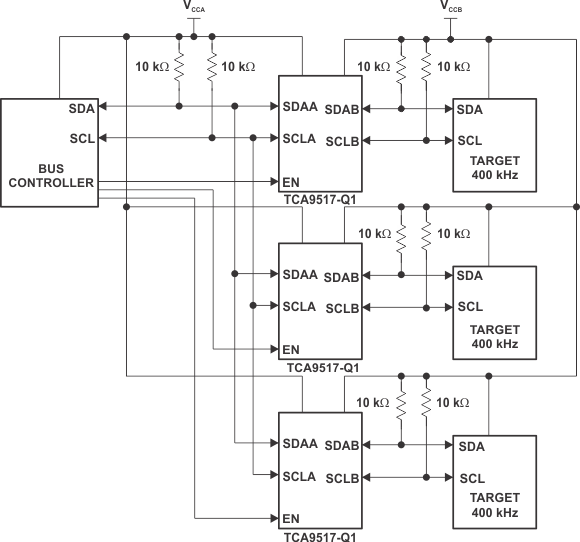SCPS237A June 2018 – February 2022 TCA9517-Q1
PRODUCTION DATA
- 1 Features
- 2 Applications
- 3 Description
- 4 Revision History
- 5 Description (continued)
- 6 Pin Configuration and Functions
- 7 Specifications
- 8 Parameter Measurement Information
- 9 Detailed Description
- 10Application and Implementation
- 11Power Supply Recommendations
- 12Layout
- 13Device and Documentation Support
Package Options
Mechanical Data (Package|Pins)
- DGK|8
Thermal pad, mechanical data (Package|Pins)
- DGK|8
Orderable Information
10.2.2.2 VILC and Pullup Resistor Sizing
For the TCA9517-Q1 to function correctly, all devices on the B-side must be able to pull the B-side below the voltage input low contention level (VILC). This means that the VOL of any device on the B-side must be below
0.4 V.
VOL of a device can be adjusted by changing the IOL through the device which is set by the pull-up resistance value. The pull-up resistance on the B-side must be carefully selected to ensure that logic levels will be transferred correctly to the A-side.
 Figure 10-2 Typical Star Application
Figure 10-2 Typical Star ApplicationMultiple A sides of TCA9517-Q1s can be connected in a star configuration, allowing all nodes to communicate with each other.
 Figure 10-3 Typical Series Application
Figure 10-3 Typical Series ApplicationTo further extend the I2C bus for long traces/cables, multiple TCA9517-Q1s can be connected in series as long as the A-side is connected to the B-side. I2C bus target devices can be connected to any of the bus segments. The number of devices that can be connected in series is limited by repeater delay/time-of-flight considerations on the maximum bus speed requirements.
 Figure 10-4 Bus A (0.9 V to 5.25 V Bus) Waveform
Figure 10-4 Bus A (0.9 V to 5.25 V Bus) Waveform Figure 10-5 Bus B (2.7 V to 5.25 V Bus) Waveform
Figure 10-5 Bus B (2.7 V to 5.25 V Bus) Waveform